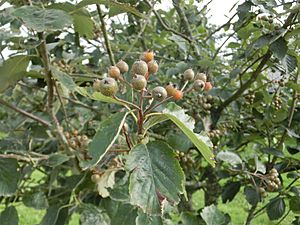Karpatiosorbus devoniensis facts for kids
Quick facts for kids Karpatiosorbus devoniensis |
|
|---|---|
 |
|
| Devon whitebeam, leaves and young fruit | |
| Conservation status | |
| Scientific classification | |
| Genus: |
Karpatiosorbus
|
| Species: |
devoniensis
|
| Synonyms | |
|
|
Karpatiosorbus devonensis is known by the English name of Devon whitebeam and locally as otmast. It is a species of whitebeam tree in the family Rosaceae. It is endemic to the British Isles, growing wild only in areas of Devon, Cornwall, Somerset and Ireland.
It did not exist before the last ice age, probably arising from a hybrid between the wild service tree and another whitebeam. It is a close relative of the No Parking whitebeam, Karpatiosorbus admonitor, which occupies the same range and is known to hybridise with the Devon whitebeam.
Description
It will form a deciduous tree to about 12 metres height.
The leaves are entire, lobed, are dark green above, underside has a dense layer of white hairs.
It flowers at the end of May, they are white with 5 petals.
The fruits ripen at the end of October. They are orange brown, and edible.
Locations found
- along the River Taw and River Torridge
- Roborough Down in Plymouth
- Little Haldon, at Bishopsteignton
- Boyton, Cornwall
- South East and North East Ireland (rarely)
- Halsdon Nature Reserve near Great Torrington managed by the Devon Wildlife Trust - one tree
- Uppacott Wood Nature reserve between Barnstaple and Bideford also managed by the Devon Wildlife Trust, has many trees
- Watergate Bridge near Great Torrington, grid ref SS468175 (questionable as bright red berries)
- Leigh Cross, Zeal Monachorum, map grid ref SS698047
- Watergate, Horwood, ref SS502266
- Washington Park Arboretum in Seattle, WA, USA
Images for kids



